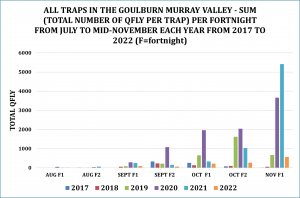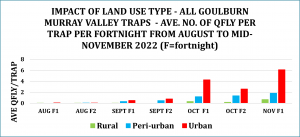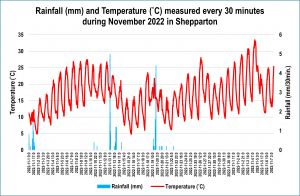This information has been commissioned by the Goulburn Murray Valley Area Wide Management Fruit Fly Program and is funded by the Victorian Government. Use of this material in its complete and original format, acknowledging its source, is permitted, however unauthorised alterations to the text or content is not permitted.
Current Queensland fruit fly trap capture
The Goulburn Murray Valley regional trapping grid trapped and recorded a total of 484 Queensland fruit fly during October 2022. This compares with only 26 for August 2022 and 151 for September 2022. Up until the first two weeks of November, 570 Queensland fruit fly were captured. This heralds the start on the next expansion in fruit fly population which will peak in early to mid-January.
Queensland fruit fly numbers for early October 2022 are similar to those trapped at the same times in 2021, but late October and early November are a lot less than for the same periods in the previous two years (Tables 1, 2 and Fig. 1). On average, Nov 2022 trapped flies at lower rates (Table 3). Rain and cooler maximum temperatures have delayed the typical spring peak for trapped fruit fly due to La Niña weather conditions. It is also likely that community-led management programs with tree removals, signage, media activities and education under the regional Area-wide Fruit Fly Management program has contributed to the current decline.
Table 1. Total Queensland fruit fly trapped in the Goulburn Murray Valley during July to mid-September from 2020 to 2022.
| Year | Sept wk1&2 | Sept wk3&4 | Oct wk1&2 | Oct wk3&4 | Nov wk1&2 |
| 2020 | 269 | 206 | 397 | 2042 | 3661 |
| 2021 | 245 | 135 | 204 | 1032 | 5416 |
| 2022 | 90 | 61 | 216 | 268 | 570 |
Table 2. Partial seasonal totals of Queensland fruit fly from 2017 to mid-Nov 2022.
| Qfly activity season | Total (1 July to mid-Nov) |
| 2017/18 | 711 |
| 2018/19 | 592 |
| 2019/20 | 3218 |
| 2020/21 | 9148 |
| 2021/22 | 7335 |
| 2022/23 | 1265 |
Fig. 1. Total number of Queensland fruit fly per trap per fortnight from July – mid November each year from 2017-22

Sites of concern (potential hot spots)
There were five locations within the Goulburn Murray Valley where Queensland fruit fly numbers trapped were higher than the Goulburn Murray Valley average (1.88 Qfly/trap/fortnight) during the first two weeks of November 2022 (Table 3).
Table 3. Potential Queensland fruit fly higher numbers for November 2022 in the Goulburn Murray Valley
| COBRAM |
| KYABRAM |
| MOOROOPNA |
| SHEPPARTON |
| TATURA |
If you live in or near these locations, please have monitoring traps out and check any nearby ripening, ripe or overripe fruit within the vicinity for the presence of Queensland fruit fly. It is best to start monitoring by the beginning of September 2022 in the Goulburn Murray Valley.
Peri-urban, rural and urban impacts on Queensland fruit fly
Generally, Queensland fruit fly populations in urban areas expand earlier in the season than in peri-urban and rural sites. This trend continued in 2022 (Fig. 2). This phenomenon occurs each year and signifies that fruit fly build up their population in urban areas where temperatures are generally higher, ripe and ripening fruit are more accessible and water is more available via home garden watering, than rural locations at this time of year. It’s also the source of incursions into nearby commercial horticultural areas when their fruit is ripening through to autumn 2023. If urban fruit fly can be managed, then it will benefit commercial production.
Fig. 2

Current weather
As usual from mid-August to mid-November, the weather warmed up with intermittent returns to wintry conditions. Minimum daily temperatures, during November 2022, ranged from 4.8˚C to 16.7˚C. Negligible rainfall has occurred since 20 November and this normally impacts adversely on fruit fly survival but other conditions (solar radiation, evaporation, etc) show that humidity is relatively high even without the rain. These conditions favour Queensland fruit fly survival especially in urban locations where fruit availability is high and garden irrigation is present. Several spikes in minimum temperatures occurred within the Goulburn Murray Valley during October which were associated with rainfall (Fig. 3). Queensland fruit fly trapping rates usually increase under these early spring conditions.
Data (Table 4) show that the year 2022 in the Goulburn Murray Valley was wetter and more humid than usual, with more rainfall, less evaporation and lower solar radiation and lower maximum and minimum temperatures. This type of weather pattern benefits survival and population expansion of fruit fly in the Goulburn Murray Valley.
The 2022 weather conditions support the possibility that Queensland fruit fly population expansion has been delayed when compared with previous years. Because temperatures and rainfall have not been damaging to fruit fly survival this means that adults and their immature stages (i.e. eggs, larvae and pupae) will still survive in large numbers but not become problematic until later in the season than normal. That is, unless effective instigation and continuation of community led Area Wide Management strategies are in place.
Fig. 3. Rainfall and temperature measured during November in Shepparton

Weather outlook
The Bureau of Meteorology outlook for the Goulburn Murray Valley suggests that:
- RAIN – The chance of exceeding the median monthly rate of rainfall for the Goulburn Murray Valley (10mm to 25mm in the north of the Goulburn Murray Valley and 25mm to 50mm in the south) is 60% to 65%. This indicates a likely increase above the average in rainfall for the Goulburn Murray Valley in December 2022.
- TEMP. – The chance of maximum daily temperatures in the Goulburn Murray Valley being higher than the median (30˚C to 33˚C in the north of the Goulburn Murray Valley and 27˚C to 30˚C in the south) is 20% to 30%. This means that maximum daily temperatures in the Goulburn Murray Valley are likely to be lower than usual during December 2022.
- TEMP. – The chance of minimum daily temperatures in the Goulburn Murray Valley being higher than the median (12˚C to 15˚C) is 60% to 70%. This means that minimum daily temperatures in the Goulburn Murray Valley are likely to be higher than usual during December 2022.
Queensland fruit fly outlook
Higher than usual rainfall and daily minimum temperatures, and neutral maximum temperatures (Table 5) indicate highly favourable conditions for overwintering adult fruit fly to emerge from their winter refuges and find fruit to infest. This is especially the case as Queensland fruit fly mating thresholds are being achieved every day now.
Prediction for a third consecutive La Niña event for late 2022 and early 2023 has been confirmed.
Table 5. Summary – forecasts for the Goulburn Murray Valley in December 2022
| EVENT | CHANCE ABOVE USUAL LEVEL (%) [LIKELIHOOD] | USUAL LEVEL (mm OR ˚C) | IMPACT ON QLD FRUIT FLY SURVIVAL AND POPULATION EXPANSION |
| RAINFALL | 60 to 65
[HIGH] |
10 to 25 (north)
25 to 50 (south) |
BENEFICIAL TO QFLY |
| MAX. TEMP. | 20 to 30
[LOW] |
30 to 33 (north)
27 to 30 (south) |
BENEFICIAL TO QFLY |
| MIN. TEMP. | 60 to 70
[HIGH] |
12 to 15 | BENEFICIAL TO QFLY |
Queensland fruit fly management programs and strategies followed throughout the season will help keep fruit fly under control. The importance of whole-of community awareness and participation cannot be understated and is critical in stopping the spread.
Goulburn Murray Valley Area Wide Management Fruit Fly Program
For assistance in managing fruit fly, contact the Project Coordinator at the Goulburn Murray Valley Fruit Fly Office by phoning (03) 5871 9222 or email gmvfruitfly@moira.vic.gov.au.
